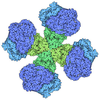+ Open data
Open data
- Basic information
Basic information
| Entry | Database: PDB / ID: 2h2f | ||||||
|---|---|---|---|---|---|---|---|
| Title | The Structural basis for Sirtuin Substrate affinity | ||||||
 Components Components |
| ||||||
 Keywords Keywords | HYDROLASE / Sir2Tm | ||||||
| Function / homology |  Function and homology information Function and homology informationprotein acetyllysine N-acetyltransferase / histone deacetylase activity, NAD-dependent / negative regulation of helicase activity / Loss of function of TP53 in cancer due to loss of tetramerization ability / Regulation of TP53 Expression / signal transduction by p53 class mediator / negative regulation of G1 to G0 transition / negative regulation of glucose catabolic process to lactate via pyruvate / Transcriptional activation of cell cycle inhibitor p21 / regulation of intrinsic apoptotic signaling pathway by p53 class mediator ...protein acetyllysine N-acetyltransferase / histone deacetylase activity, NAD-dependent / negative regulation of helicase activity / Loss of function of TP53 in cancer due to loss of tetramerization ability / Regulation of TP53 Expression / signal transduction by p53 class mediator / negative regulation of G1 to G0 transition / negative regulation of glucose catabolic process to lactate via pyruvate / Transcriptional activation of cell cycle inhibitor p21 / regulation of intrinsic apoptotic signaling pathway by p53 class mediator / negative regulation of pentose-phosphate shunt / ATP-dependent DNA/DNA annealing activity / Activation of NOXA and translocation to mitochondria / regulation of cell cycle G2/M phase transition / oligodendrocyte apoptotic process / negative regulation of miRNA processing / intrinsic apoptotic signaling pathway in response to hypoxia / regulation of fibroblast apoptotic process / positive regulation of thymocyte apoptotic process / oxidative stress-induced premature senescence / regulation of tissue remodeling / positive regulation of mitochondrial membrane permeability / mRNA transcription / bone marrow development / positive regulation of programmed necrotic cell death / circadian behavior / T cell proliferation involved in immune response / regulation of mitochondrial membrane permeability involved in apoptotic process / germ cell nucleus / RUNX3 regulates CDKN1A transcription / homolactic fermentation / TP53 Regulates Transcription of Death Receptors and Ligands / Activation of PUMA and translocation to mitochondria / TP53 regulates transcription of additional cell cycle genes whose exact role in the p53 pathway remain uncertain / histone deacetylase regulator activity / regulation of DNA damage response, signal transduction by p53 class mediator / negative regulation of glial cell proliferation / Regulation of TP53 Activity through Association with Co-factors / negative regulation of neuroblast proliferation / mitochondrial DNA repair / T cell lineage commitment / Formation of Senescence-Associated Heterochromatin Foci (SAHF) / ER overload response / thymocyte apoptotic process / B cell lineage commitment / TP53 Regulates Transcription of Caspase Activators and Caspases / entrainment of circadian clock by photoperiod / cardiac septum morphogenesis / negative regulation of mitophagy / negative regulation of DNA replication / Zygotic genome activation (ZGA) / Association of TriC/CCT with target proteins during biosynthesis / PI5P Regulates TP53 Acetylation / TP53 Regulates Transcription of Genes Involved in Cytochrome C Release / necroptotic process / positive regulation of release of cytochrome c from mitochondria / negative regulation of telomere maintenance via telomerase / SUMOylation of transcription factors / TP53 regulates transcription of several additional cell death genes whose specific roles in p53-dependent apoptosis remain uncertain / TFIID-class transcription factor complex binding / intrinsic apoptotic signaling pathway by p53 class mediator / rRNA transcription / negative regulation of reactive oxygen species metabolic process / Transcriptional Regulation by VENTX / cellular response to UV-C / replicative senescence / viral process / general transcription initiation factor binding / intrinsic apoptotic signaling pathway in response to endoplasmic reticulum stress / NAD+ binding / positive regulation of RNA polymerase II transcription preinitiation complex assembly / cellular response to actinomycin D / neuroblast proliferation / intrinsic apoptotic signaling pathway in response to DNA damage by p53 class mediator / positive regulation of execution phase of apoptosis / Pyroptosis / hematopoietic stem cell differentiation / embryonic organ development / response to X-ray / chromosome organization / type II interferon-mediated signaling pathway / somitogenesis / TP53 Regulates Transcription of Genes Involved in G1 Cell Cycle Arrest / hematopoietic progenitor cell differentiation / negative regulation of fibroblast proliferation / positive regulation of cardiac muscle cell apoptotic process / core promoter sequence-specific DNA binding / glial cell proliferation / negative regulation of stem cell proliferation / cellular response to glucose starvation / cis-regulatory region sequence-specific DNA binding / mitophagy / Regulation of TP53 Activity through Acetylation / positive regulation of intrinsic apoptotic signaling pathway / response to salt stress / 14-3-3 protein binding / mitotic G1 DNA damage checkpoint signaling / negative regulation of proteolysis / gastrulation / cardiac muscle cell apoptotic process Similarity search - Function | ||||||
| Biological species |   Thermotoga maritima (bacteria) Thermotoga maritima (bacteria) | ||||||
| Method |  X-RAY DIFFRACTION / X-RAY DIFFRACTION /  SYNCHROTRON / SYNCHROTRON /  MOLECULAR REPLACEMENT / Resolution: 2.2 Å MOLECULAR REPLACEMENT / Resolution: 2.2 Å | ||||||
 Authors Authors | Cosgrove, M.S. / Wolberger, C. | ||||||
 Citation Citation |  Journal: Biochemistry / Year: 2006 Journal: Biochemistry / Year: 2006Title: The structural basis of sirtuin substrate affinity Authors: Cosgrove, M.S. / Bever, K. / Avalos, J.L. / Muhammad, S. / Zhang, X. / Wolberger, C. | ||||||
| History |
|
- Structure visualization
Structure visualization
| Structure viewer | Molecule:  Molmil Molmil Jmol/JSmol Jmol/JSmol |
|---|
- Downloads & links
Downloads & links
- Download
Download
| PDBx/mmCIF format |  2h2f.cif.gz 2h2f.cif.gz | 62.4 KB | Display |  PDBx/mmCIF format PDBx/mmCIF format |
|---|---|---|---|---|
| PDB format |  pdb2h2f.ent.gz pdb2h2f.ent.gz | 44.6 KB | Display |  PDB format PDB format |
| PDBx/mmJSON format |  2h2f.json.gz 2h2f.json.gz | Tree view |  PDBx/mmJSON format PDBx/mmJSON format | |
| Others |  Other downloads Other downloads |
-Validation report
| Summary document |  2h2f_validation.pdf.gz 2h2f_validation.pdf.gz | 435.3 KB | Display |  wwPDB validaton report wwPDB validaton report |
|---|---|---|---|---|
| Full document |  2h2f_full_validation.pdf.gz 2h2f_full_validation.pdf.gz | 437 KB | Display | |
| Data in XML |  2h2f_validation.xml.gz 2h2f_validation.xml.gz | 11.8 KB | Display | |
| Data in CIF |  2h2f_validation.cif.gz 2h2f_validation.cif.gz | 15.9 KB | Display | |
| Arichive directory |  https://data.pdbj.org/pub/pdb/validation_reports/h2/2h2f https://data.pdbj.org/pub/pdb/validation_reports/h2/2h2f ftp://data.pdbj.org/pub/pdb/validation_reports/h2/2h2f ftp://data.pdbj.org/pub/pdb/validation_reports/h2/2h2f | HTTPS FTP |
-Related structure data
| Related structure data |  2h2dC 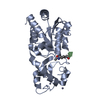 2h2gC 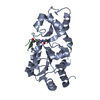 2h2hC  2h2iSC S: Starting model for refinement C: citing same article ( |
|---|---|
| Similar structure data |
- Links
Links
- Assembly
Assembly
| Deposited unit | 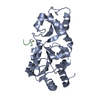
| ||||||||
|---|---|---|---|---|---|---|---|---|---|
| 1 |
| ||||||||
| Unit cell |
|
- Components
Components
| #1: Protein | Mass: 27569.793 Da / Num. of mol.: 1 Source method: isolated from a genetically manipulated source Source: (gene. exp.)   Thermotoga maritima (bacteria) / Gene: npdA / Production host: Thermotoga maritima (bacteria) / Gene: npdA / Production host:  References: UniProt: Q9WYW0, Hydrolases; Acting on carbon-nitrogen bonds, other than peptide bonds; In linear amides |
|---|---|
| #2: Protein/peptide | Mass: 2098.491 Da / Num. of mol.: 1 / Source method: obtained synthetically Details: THE SEQUENCE OF THE PEPTIDE IS NATURALLY FOUND IN HOMO SAPIENS (HUMAN). References: UniProt: P04637 |
| #3: Chemical | ChemComp-ZN / |
| #4: Water | ChemComp-HOH / |
-Experimental details
-Experiment
| Experiment | Method:  X-RAY DIFFRACTION / Number of used crystals: 1 X-RAY DIFFRACTION / Number of used crystals: 1 |
|---|
- Sample preparation
Sample preparation
| Crystal | Density Matthews: 2.42 Å3/Da / Density % sol: 49.09 % |
|---|---|
| Crystal grow | Temperature: 298 K / pH: 9.6 Details: 20% PEG, pH 9.6, VAPOR DIFFUSION, HANGING DROP, temperature 298K, pH 9.60 |
-Data collection
| Diffraction | Mean temperature: 100 K |
|---|---|
| Diffraction source | Source:  SYNCHROTRON / Site: SYNCHROTRON / Site:  NSLS NSLS  / Beamline: X25 / Wavelength: 1.1 / Beamline: X25 / Wavelength: 1.1 |
| Detector | Detector: CCD / Date: Aug 14, 2004 |
| Radiation | Protocol: SINGLE WAVELENGTH / Monochromatic (M) / Laue (L): M / Scattering type: x-ray |
| Radiation wavelength | Wavelength: 1.1 Å / Relative weight: 1 |
| Reflection | Resolution: 2.1→50 Å / Num. obs: 17279 / % possible obs: 99.2 % / Observed criterion σ(I): 2 / Redundancy: 6.2 % / Biso Wilson estimate: 23.3 Å2 / Rmerge(I) obs: 0.092 / Rsym value: 0.065 / Net I/σ(I): 29.2 |
| Reflection shell | Resolution: 2.1→2.18 Å / Redundancy: 5.5 % / Rmerge(I) obs: 0.66 / Mean I/σ(I) obs: 3.7 / Rsym value: 0.559 / % possible all: 98.6 |
- Processing
Processing
| Software |
| ||||||||||||||||||||||||||||||||||||||||||||||||||||||||||||
|---|---|---|---|---|---|---|---|---|---|---|---|---|---|---|---|---|---|---|---|---|---|---|---|---|---|---|---|---|---|---|---|---|---|---|---|---|---|---|---|---|---|---|---|---|---|---|---|---|---|---|---|---|---|---|---|---|---|---|---|---|---|
| Refinement | Method to determine structure:  MOLECULAR REPLACEMENT MOLECULAR REPLACEMENTStarting model: PDB Entry: 2H2I Resolution: 2.2→7.96 Å / Rfactor Rfree error: 0.009 / Data cutoff high absF: 1289818.32 / Data cutoff low absF: 0 / Isotropic thermal model: RESTRAINED / Cross valid method: THROUGHOUT / σ(F): 0 / Stereochemistry target values: ENGH & HUBER
| ||||||||||||||||||||||||||||||||||||||||||||||||||||||||||||
| Solvent computation | Solvent model: FLAT / Bsol: 704696 Å2 / ksol: 0.579667 e/Å3 | ||||||||||||||||||||||||||||||||||||||||||||||||||||||||||||
| Displacement parameters | Biso mean: 38 Å2
| ||||||||||||||||||||||||||||||||||||||||||||||||||||||||||||
| Refine analyze |
| ||||||||||||||||||||||||||||||||||||||||||||||||||||||||||||
| Refinement step | Cycle: LAST / Resolution: 2.2→7.96 Å
| ||||||||||||||||||||||||||||||||||||||||||||||||||||||||||||
| Refine LS restraints |
| ||||||||||||||||||||||||||||||||||||||||||||||||||||||||||||
| LS refinement shell | Resolution: 2.2→2.33 Å / Rfactor Rfree error: 0.024 / Total num. of bins used: 6
|
 Movie
Movie Controller
Controller



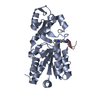
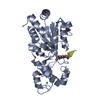

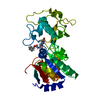
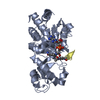
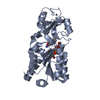
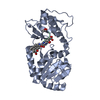
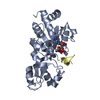


 PDBj
PDBj




